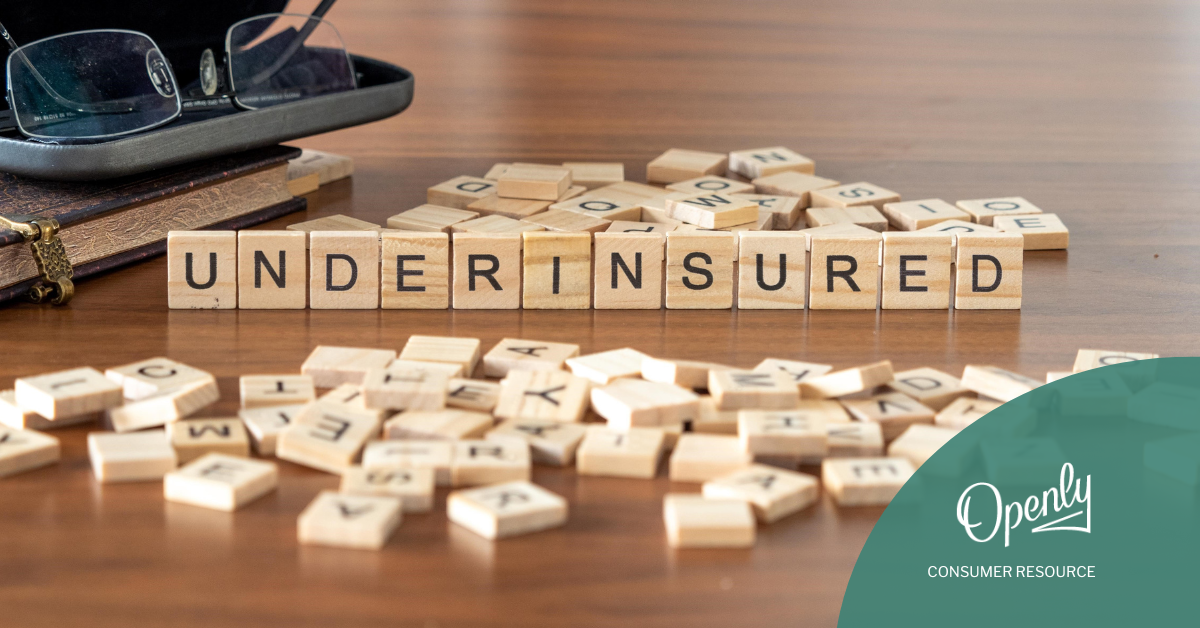When disaster strikes your home, the last thing you want to discover is that your insurance coverage falls short of what you actually need. Unfortunately, this scenario—known as being underinsured—affects millions of homeowners across the country.
Being underinsured doesn’t mean you’re without insurance. Instead, it means your current coverage limits are too low to fully protect you from big financial losses. This coverage gap can leave you paying thousands out-of-pocket, right when you’re already dealing with the stress of property damage, medical bills, or other losses from an accident, fire, or other covered event.
Keep reading to learn more about underinsurance and what you can do to prevent being underinsured.
At a glance:
- Being underinsured means your insurance coverage limits are too low to fully protect you from major financial losses, leaving you to pay thousands out-of-pocket when disaster strikes.
- Underinsurance typically develops gradually through rising construction costs, inflationary costs, home improvements that aren't reported to insurers, and outdated policies.
- Guaranteed replacement cost coverage is one of the most effective protections against underinsurance, as it is coverage towards rebuilding your home to its original condition.
What is underinsured in home insurance?
In the context of home insurance, being underinsured means having less coverage than what's actually needed to fully rebuild or repair your home to its current condition. This gap between your policy limits and your actual replacement costs can create serious financial vulnerabilities for any homeowner.
Understanding this term matters for every homeowner because underinsurance is more common than most people realize. Many policyholders assume their coverage amounts are adequate simply because they've been paying premiums regularly, but insurance needs can change over time while policy limits can remain static. Without periodic reviews and updates, even well-intentioned homeowners can find themselves in this vulnerable position.
Imagine a storm damages your house—and then you find out your insurance won’t cover the full cost to repair or rebuild due to the repairs exceeding the policy limits. That’s what it means to be underinsured: your policy exists, but it doesn’t go far enough when you need it most. Unfortunately, this is a reality for many homeowners, often discovered only when disaster strikes.
How does underinsurance happen?
Underinsurance rarely happens overnight. Instead, it sneaks up gradually through several common scenarios that catch homeowners off guard.
Rising costs
Inflation represents one of the most significant factors driving underinsurance. The price of building materials, labor rates, and construction costs tend to climb over time. But not all insurance policies automatically adjust coverage limits. What seemed like adequate coverage when you first purchased your policy a few years ago might be far too little today. Recent years have seen particularly dramatic increases in building materials and construction labor, making this challenge even more pronounced.
Home improvements
Renovating your kitchen, adding a deck, finishing a basement, or any other modifications to your home can create another pathway to underinsurance. When you make home improvements, you're increasing your home's replacement cost. However, these improvements won't automatically increase your coverage limits unless you specifically notify your insurance company and request policy adjustments. Even seemingly minor improvements can add up to significant coverage gaps over time.
Outdated policies
Life gets busy. Many people set their home insurance coverage and forget about it. During those years of benign neglect, property values rise, construction costs increase, and personal belongings accumulate.
Homeowner assumptions
The tricky aspect of underinsurance is that it can happen even when homeowners believe they have "enough" coverage. You might have purchased what seemed like comprehensive protection initially, but changing circumstances can gradually erode that protection without any obvious warning signs. It’s easy to assume your coverage is still sufficient just because you’re paying your premiums. But insurance needs change, and existing policy limits won’t always be adequate.
What financial risks does being underinsured pose?
The financial impact of underinsurance can be devastating, particularly during disasters when you're least prepared to handle additional financial stress. Understanding these risks helps illustrate why maintaining adequate coverage is so important. The financial risks are real—and they can be severe.
Major out-of-pocket costs
Out-of-pocket expenses for repairs or rebuilding represent the most direct financial consequence of underinsurance. When your policy limits fall short of actual costs, you become personally responsible for the difference. This coverage gap can easily reach tens of thousands of dollars or more, depending on the extent of the damage and the size of your coverage shortfall.
Partial claim payouts
Insurance may only pay part of your repair costs, leaving you scrambling to find the rest elsewhere to complete necessary repairs.
Long-term financial strain
The stress and financial strain of trying to cover these gaps—while also handling the emotional fallout of a disaster—can lead to debt or force tough choices about repairs. Dealing with contractors, insurance adjusters, and repair timelines is challenging enough without worrying about how you'll cover unexpected costs. Underinsurance can turn what should be a manageable insurance claim into a prolonged financial hardship.
Liability gaps
Another example involves liability coverage limits. If someone is injured on your property and their medical bills and legal settlements exceed your liability coverage, you could be on the hook for the remainder. This situation can threaten your financial security for years to come.
How can you avoid being underinsured?
Preventing underinsurance requires proactive management of your insurance coverage and regular attention to changing circumstances. Staying fully protected doesn’t have to be complicated. Here’s what you can do:
Review your policy annually
Regularly reviewing and updating your home insurance policy should become an annual habit. Schedule a specific time each year—such as when you receive your home insurance renewal notice—to assess whether your coverage limits still match your needs. Factor in any home improvements, belongings, or local costs that might affect your coverage requirements.
Get accurate replacement cost estimates
Don’t rely on your home’s market value. Instead, get an accurate, up-to-date home replacement cost estimate to determine how much it would cost to rebuild your home today. These estimates should account for local construction costs, the unique features of your property, and current material prices. Remember that replacement cost differs from market value—you need enough coverage to rebuild your home, not necessarily to match its sale price.
Consider enhanced coverage options
Consider policies with guaranteed replacement cost or extended replacement cost coverage options. These policy features provide additional protection against underinsurance by covering rebuilding costs, although coverage may vary by state. While these options may cost slightly more upfront, they can provide valuable peace of mind and financial protection against unexpected cost overages.
Update after renovations
Working with an independent insurance agent to review coverage needs after improvements ensures your policy keeps pace with changes to your home. Any time you make a renovation or update to your home, notify your insurance agent about these changes; they can help calculate how improvements affect your coverage needs and adjust your policy accordingly.
Understand your policy limits
Knowing what your policy covers, what it doesn't, and what additional coverage options might be available is incredibly important. For example, standard homeowners insurance typically doesn't cover flood damage, which might require separate flood insurance. Similarly, high-value items like jewelry or art might need additional coverage beyond standard contents limits.
The role of guaranteed replacement cost coverage
Guaranteed replacement cost coverage represents one of the most effective tools for protecting against underinsurance. This protection guards against construction cost inflation, material shortages, and other factors that might drive rebuilding costs higher than originally anticipated. This is especially valuable in areas prone to natural disasters, where rebuilding costs can skyrocket due to high demand.
This coverage works by removing the policy limit cap for dwelling coverage in total loss situations. If your home is destroyed and rebuilding costs $450,000 but your policy limit is $400,000, guaranteed replacement cost coverage would pay the full $450,000. Without this coverage, you'd be responsible for the $50,000 difference, in addition to your deductible.
Through its network of independent agents, Openly offers products with coverage options designed to protect against these risks, including extended replacement cost coverage that provides additional protection beyond standard policy limits. These options reflect the company's understanding that adequate coverage requires more than just basic policy minimums.
What should you do next?
Taking action to address potential underinsurance starts with honestly assessing your current coverage situation. Don't wait until disaster strikes to find out you’re underinsured. Here’s how to get started:
- Review your current policy. Look at your coverage limits for your dwelling, other structures, personal property, and liability.
- Compare your limits to current replacement costs.
- Schedule a policy review with your insurance agent, who can walk you through your options and help you identify potential coverage gaps; they can even help you estimate the replacement cost.
- Get updated coverage quotes to see what it would cost to increase your limits or add guaranteed replacement cost coverage (if you don’t currently have the latter). You might discover that increasing your coverage limits or adding guaranteed replacement cost coverage costs less than you expected.
Being underinsured means you're unknowingly retaining more risk than necessary. Don't let underinsurance leave you vulnerable to financial catastrophe. Take the time to review your coverage, understand your risks, and make sure your insurance protection matches your actual needs. Your future self will thank you for the foresight and preparation.
We provide this information to help you understand insurance. Any coverage is subject to the terms of your policy. Please refer to your policy and declarations page for complete terms, conditions, exclusions and coverage details. Openly may provide links that lead to an external website that may promote goods and services that Openly does not endorse. We are not responsible for the content, claims, or representations made on the linked website. Please review their terms and policies before engaging with any offerings.




